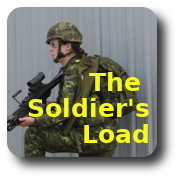
The Soldier's Load
 The first thing that any initial investigation into the soldier's load established is that, historically and in the modern era, the dismounted soldier is overloaded. After that come the realizations that economies in one part of the load are swiftly occupied by new items, with a resulting capability advantage but no ability bonus. Changing the soldier's load is about command decisions and risk management. Increases to personal protective gear in the modern era can be a significant part of the modern combat soldier's load, with the result that it becomes even more difficult to find those parts that can be reduced with acceptable risk.
The first thing that any initial investigation into the soldier's load established is that, historically and in the modern era, the dismounted soldier is overloaded. After that come the realizations that economies in one part of the load are swiftly occupied by new items, with a resulting capability advantage but no ability bonus. Changing the soldier's load is about command decisions and risk management. Increases to personal protective gear in the modern era can be a significant part of the modern combat soldier's load, with the result that it becomes even more difficult to find those parts that can be reduced with acceptable risk.
The following articles are offered as historic examples of the soldier's load dilemma. What soldiers carry, both on the march and in combat, affect their efficiency, and their ability to fight and win. Improved technology and supporting combat systems contribute greatly to the fight, but the last hundred metres will always be fought by the dismounted soldier on the ground, fighting with the arms they carry and the energy they have conserved to that point in the fight. Soldiers' loads, the physical demands they create, and the psychological factors that have impacts on limits of exertion all continue to compose a challenge for commanders to find an optimal solution.

Soldier's Load posts on The Minute Book (blog)
- Soldiers Load (Canadian Militia, 1870)
- The Soldier's Load — The RCR at Vimy Ridge
- FSPB 1914 — Dismounted Soldiers
- Germany 1900-1914
- The Lewis Gun Section (1925)
- Platoon Weapons and Ammunition (1942)
- A historic problem
- The Soldier's Load (1871)
- A Soldier's Load
- The Infantry Platoon; 1942
- Dress and Equipment (1918)
- Soldier's Load; North Africa
- The Soldier's Load; Vietnam
- Factors Causing Soldiers' Overload
- The Soldiers Load; Australia
- The Soldier's Load in Vietnam
- Soldiers' Load — US Army — 1916
- Burden Put on Doughboy
- Sending Men to Death by Overloading
- To Test New Equipment (US Army, 1911)
- Exhaustible Infantry
- What a Soldier Carries
- The Burden the Soldier Boy Carries (1918)
- Japanese Soldier's Load (1910)
- Heaviest Laden Pack Animal in American Army
- Soldier's Kit in South Africa
- [US] Army Tries to Reduce Pack Weight (1963)
- The Soldier's Kit (1932)
- With a 70-Pound Pack (US Army, 1925)
- The Soldier's Load, Canadian Militia (1868)
- Commando Arms and Equipment
- The O'Leary Collection; Medals of The Royal Canadian Regiment.
- Researching Canadian Soldiers of the First World War
- Researching The Royal Canadian Regiment
- The RCR in the First World War
- Badges of The RCR
- The Senior Subaltern
- The Minute Book
- Rogue Papers
- Tactical Primers
- The Regimental Library
- Battle Honours
- Perpetuation of the CEF
- A Miscellany
- Quotes
- The Frontenac Times
- Site Map
QUICK LINKS

- The Service Kit of the Infantry Soldier (1901)
- The Load Carried by the Soldier (1921)
- The Equipment of the Infantry Soldier In the Light of War Experience (1923)
- The Mobility of One Man (1949)
- Keep The Doughboy Lightly Loaded (1950)
- The Soldier's Load (1955)
- The Accoutrements of the British Infantryman, 1640 To 1940
- A Soldier's Load (1987)
- The Soldier's Load; Planning Smart (1990)
- Soldier Load; When Technology Fails (1987)
- Load Carrying Ability (1990)
- Roadmarching and Performance (1990)
Soldier's Load posts on The Minute Book (blog)
- Soldiers Load (Canadian Militia, 1870)
- The Soldier's Load — The RCR at Vimy Ridge
- FSPB 1914 — Dismounted Soldiers
- Germany 1900-1914
- The Lewis Gun Section (1925)
- Platoon Weapons and Ammunition (1942)
- A historic problem
- The Soldier's Load (1871)
- A Soldier's Load
- The Infantry Platoon; 1942
- Dress and Equipment (1918)
- Soldier's Load; North Africa
- The Soldier's Load; Vietnam
- Factors Causing Soldiers' Overload
- The Soldiers Load; Australia
- The Soldier's Load in Vietnam
- Soldiers' Load — US Army — 1916
- Burden Put on Doughboy
- Sending Men to Death by Overloading
- To Test New Equipment (US Army, 1911)
- Exhaustible Infantry
- What a Soldier Carries
- The Burden the Soldier Boy Carries (1918)
- Japanese Soldier's Load (1910)
- Heaviest Laden Pack Animal in American Army
- Soldier's Kit in South Africa
- [US] Army Tries to Reduce Pack Weight (1963)
- The Soldier's Kit (1932)
- With a 70-Pound Pack (US Army, 1925)
- The Soldier's Load, Canadian Militia (1868)
- Commando Arms and Equipment